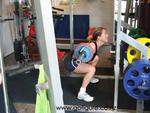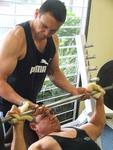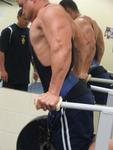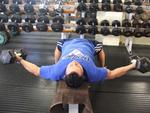7 training methods to break plateaus
When each set is set in stone and each repetition has become, well, repetitious, you're either heading for or have already reached the dreaded "plateau" in weight training. In other words, you are stuck in a monotonous weight-training rut, where both mind and muscle are stagnating and your strength gains have screeched to a depressing halt.
Below are seven methods that have been used in the weightlifting world for several years and are guaranteed to help you escape that rut, overcome future plateaus, and energize your workouts. These intense methods are effective for virtually any exercise -- squats, benches, shoulder presses, leg presses, pulldowns, arm curls, and pressdowns -- and they can be used with free weights or machines.
For your second set of squats (using the same weight as in the Super Slow set), try "21" style. From the upright position, descend only a quarter of the way and back up seven times. Then, without pausing, descend to near or fully parallel, and ascend a quarter of the way, then back to parallel seven times. Finally, without taking a pause, do seven full-range squats from the parallel position. Got it? (7 x 3 = 21).
3- 1¼ Reps
Well, the first two sets were intense enough even though you were using light to moderate weight. Your third set of squats will involve "1¼ reps" with the same weight as the previous sets. Start by descending to the parallel position, ascend a quarter, return to parallel, then ascend to upright or start position. That's one rep. Aim for 8 to 12 reps using "1¼" style.
For set No. 2, try performing 6 to 8 reps in a faster, more explosive tempo to maximize power (3-1-1). Rest 30 to 45 seconds, reducing the weight another 5kg. Now go for 12 to 20 reps (2-1-1 tempo), again done explosively. This last set is all about muscular endurance as your ultimate goal is 20 reps.
6- Super Sets
Another oldie but goodie that will invigorate your workouts is the Super Set method. This is when you're doing two different exercises nonstop that work both sides of a joint, such as biceps and triceps, or doing two consecutive exercises for opposing muscles, such as hamstrings and quadriceps. Doing a set of bicep curls followed immediately by either tricep kickbacks or pressdowns (no rest in between) will really pump up the arm, while leg curls (hamstrings) followed quickly by leg extensions (quadriceps) will fatigue your leg.
The single-joint and multi-joint combo (done nonstop) trains the pectoral muscles more completely and effectively. An example for another muscle group (quadriceps) would be leg extensions (single-joint), immediately followed by either barbell squats or leg presses (multi-joint).
Below are seven methods that have been used in the weightlifting world for several years and are guaranteed to help you escape that rut, overcome future plateaus, and energize your workouts. These intense methods are effective for virtually any exercise -- squats, benches, shoulder presses, leg presses, pulldowns, arm curls, and pressdowns -- and they can be used with free weights or machines.
 |
1- Super Slow Reps This is a training method I trialled last year and it hurts! I experienced some good gains but be warned it is exhausting mentally and physically. You can check out more Super Slow info here. Super Slow protocol is when you use about 50% or 60% of your one-rep maximum, slowly descend, counting five seconds until nearly parallel. Keeping constant tension (no bouncing or pausing), slowly ascend, counting 10 seconds until you are upright at the start of the squat position. Repeat for four or five reps. The Super Slow method is intense and really works each muscle fiber. |
2- 21s
For your second set of squats (using the same weight as in the Super Slow set), try "21" style. From the upright position, descend only a quarter of the way and back up seven times. Then, without pausing, descend to near or fully parallel, and ascend a quarter of the way, then back to parallel seven times. Finally, without taking a pause, do seven full-range squats from the parallel position. Got it? (7 x 3 = 21).
3- 1¼ Reps
Well, the first two sets were intense enough even though you were using light to moderate weight. Your third set of squats will involve "1¼ reps" with the same weight as the previous sets. Start by descending to the parallel position, ascend a quarter, return to parallel, then ascend to upright or start position. That's one rep. Aim for 8 to 12 reps using "1¼" style.
For set No. 2, try performing 6 to 8 reps in a faster, more explosive tempo to maximize power (3-1-1). Rest 30 to 45 seconds, reducing the weight another 5kg. Now go for 12 to 20 reps (2-1-1 tempo), again done explosively. This last set is all about muscular endurance as your ultimate goal is 20 reps.
6- Super Sets
Another oldie but goodie that will invigorate your workouts is the Super Set method. This is when you're doing two different exercises nonstop that work both sides of a joint, such as biceps and triceps, or doing two consecutive exercises for opposing muscles, such as hamstrings and quadriceps. Doing a set of bicep curls followed immediately by either tricep kickbacks or pressdowns (no rest in between) will really pump up the arm, while leg curls (hamstrings) followed quickly by leg extensions (quadriceps) will fatigue your leg.
The single-joint and multi-joint combo (done nonstop) trains the pectoral muscles more completely and effectively. An example for another muscle group (quadriceps) would be leg extensions (single-joint), immediately followed by either barbell squats or leg presses (multi-joint).
Plateau no more
Although these seven bodybuilding and weight-training techniques have been around for years, they're anything but standard when it's time to jump-start stale workouts. For variety and a refreshing plateau-busting change, utilize these old-time methods now and then to spice up your customary sets and reps and exercise sequences. As they say, something old can become something new.





